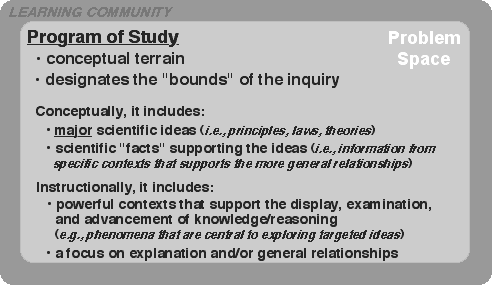

|
About GIsML Instruction |
|
The GIsML Project > Heuristic > Learning Communities
Cultural Context
The Classroom as a Learning Community
GIsML instructional activity takes place within the larger context of the program of study that is pursued by a learning community. Most commonly, the members of the learning community are the teacher and students in a particular classroom; however, in cases of collaborative activity among teachers, the learning community may include teachers and students across several classrooms. By using the language "community," we indicate our assumption that the participants in shared activity share values and beliefs that influence the progression and outcome of the activity. The designation as a learning community means that those individuals have shared values and practices relative to learning, such as: a) teaching and learning as collaborative, b) different approaches to problem situations are beneficial, c) responsibility for learning is shared, and d) authority for knowing is internal and collective (Wilcox, Schram, Lappan, Lanier, 1991) What this means is that each participant recognizes that he or she has a role to play in the community, which can range from helping others to learn, providing a particular perspective or relevant data to contribute to the knowledge building process, or prompting awareness that learning has not occurred.

Whereas the ideal is that a learning community culture is already established in the classroom, that is often not the case, and at the beginning of the year, not something that can be assumed. Thus, this culture is both desired for GIsML instruction as well as promoted by it. In the words of a teacher learning about GIsML:
One of the single most important things I'm thinking about is how do I create a classroom environment that supports inquiry based science that is appropriate across content areas because turning this environment/culture on at science time will not work. [DS journal entry, 7/8/96]
Problem Space
Scientific inquiry takes place in specific contexts relative to specific questions, and we view inquiry-based learning in the same way. We have previously used a mapmaking metaphor to describe this way of thinking about inquiry teaching (Magnusson & Palincsar, 1995), and which is responsible for referring to this aspect of GIsML instruction as the conceptual terrain.

Activity Setting- Phases of Instruction
The GIsML heuristic does not show multiple contexts, but it is meant
to imply multiple cycles due to the fact that it shows a cycle, and cycles
by definition repeat.
In t he heuristic, lines with arrows connect words in capital letters
that represent phases of instruction, and which, taken together, indicate
a cycle of investigation. A cycle always begins with the "engage"
phase and always ends with the "reporting" phase. The presence
of curved lines indicate several possible progression of phases of instruction
in a cycle of investigation. In this cycling phenomenon, students may
participate in the same phases of instruction repeatedly, either in the
same context or a different context, or they may participate in some new
phases in a cycle. For example, the curved line that leads from the "determine
real-world patterns" phase indicates a cycle in which students explore
the same or related questions or phenomena toward finding patterns and
describing relationships, which are then shared in a whole class context
GIsML instructional activity takes place within the larger context of
the program of study that is pursued by a learning community. Most commonly,
the members of the learning community are the teacher and students in
a particular classroom; however, in cases of collaborative activity among
teachers, the learning community may include teachers and students across
several classrooms. By using the language "community," we indicate
our assumption that the participants in shared activity share values and
beliefs that influence the progression and outcome of the activity. The
designation as a learning community means that those individuals have
shared values and practices relative to learning, such as: a) teaching
and learning as collaborative, b) different approaches to problem situations
are beneficial, c) responsibility for learning is shared, and d) authority
for knowing is internal and collective (Wilcox, Schram, Lappan, Lanier,
1991) What this means is that each participant recognizes that he or she
has a role to play in the community, which can range from helping others
to learn, providing a particular perspective or relevant data to contribute
to the knowledge building process, or prompting awareness that learning
has not occurred.
Whereas the ideal is that a learning community culture is already established in the classroom, that is often not the case, and at the beginning of the year, not something that can be assumed. Thus, this culture is both desired for GIsML instruction as well as promoted by it. In the words of a teacher learning about GIsML:
One of the single most important things I'm thinking about is how do I create a classroom environment that supports inquiry based science that is appropriate across content areas because turning this environment/culture on at science time will not work. [DS journal entry, 7/8/96] (reporting). Following the reporting, student would again become engaged regarding the topic at hand, and would proceed through another cycle of investigation that may result in constructing explanations following investigation rather than moving immediately on to reporting.
This progression illustrates the recursive nature of GIsML instruction that is required to promote meaningful learning, particularly with respect to scientific inquiry, because one needs sufficient experiences with examining patterns in the world before one can realistically begin deriving and testing meaningful explanations of them. In addition, this feature of "re-cycling" through phases of the instruction in relation to the same conceptual goals illustrates the important role of teachers because they play a critical role in guiding the progression of phases and determining whether and how often "re-cycling" occurs.
Heuristic home | Conceptual Terrain | Cycles of Investigation | Phases of Instruction | Types of Investigation